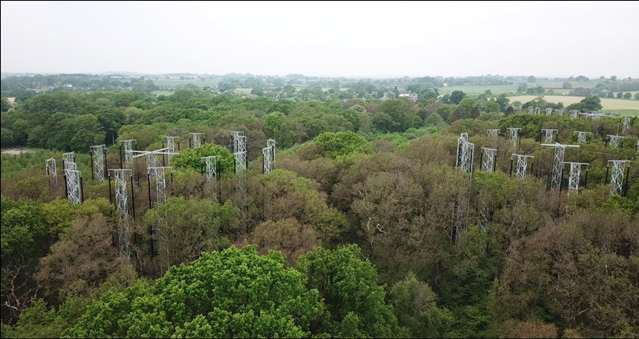Mature trees can ‘learn’ to raise CO2 absorption, study finds in potential boost for climate change
New research has found that mature oak trees can increase their rate of photosynthesis to absorb higher quantities of carbon dioxide

Mature oak trees can increase the amount of carbon dioxide they absorb, potentially giving climate scientists a new tool in their arsenal to combat the climate crisis, researchers at the University of Birmingham have discovered.
Early results from a 10-year study found that old oak forests can help to curb rising CO2 levels by increasing the amount of the gas that they absorb. While increased CO2 absorption cannot extinguish all of the issues related to carbon emissions, the research adds to a body of work that can help guide climate policy in regard to the use of forests as carbon sinks.
In the ongoing experiment, 175-year-old oak trees in the Free-Air CO2 facility at the University of Birmingham Institute of Forest Research (BIFoR) in Staffordshire were bathed in carbon dioxide-enriched air and compared with a control group that were exposed only to atmospheric CO2.
The level of CO2 used in the enriched air is 37 per cent higher than atmospheric levels and is intended to mimic levels of the gas projected to be seen in 2050.
After three years, researchers have discovered that, under conditions of elevated CO2, mature oak trees can increase their rate of photosynthesis – converting carbon dioxide and water into sugar to use as food – by up to a third. Early research suggests that they do so by absorbing and storing more of the gas from the air.
Previously, it had been thought that mature forests – those that have ceased growing vertically – could be stuck in a carbon absorption cycle, unable to change their rate of photosynthesis, but this study has shown that old trees can indeed learn new tricks.
Doctoral researcher and lead author Anna Gardner said: “The data we have collected is vital for modelling the carbon uptake of forests and has furthered our understanding of forest responses to climate change”.
“This experiment studies the oldest of such trees that have ever been examined in this regard. And so, the data is an important contribution to climate change models.”
She added: “This data is the first piece of the jigsaw in helping us understand the role of mature forests in mitigating the effects of increasing atmospheric CO2.”
Professor Rob MacKenzie, the founding director of BIFoR said: “We are sure now that the old trees are responding to future carbon dioxide levels.”
He added that this research could be crucial in guiding climate policy moving forward.
“Of the prime minister’s top four climate targets – coal, cars, cash, and trees – trees are, perhaps surprisingly, the least well-understood as a climate control lever. Our work adds to the small body of results from laboratories-in-the-forest that are essential to guide climate policy.”
Both researchers acknowledged that continued investigations were necessary to better understand how long the trees could store the additional carbon, and the effects on the entire forest ecosystem. Over the coming years of the investigation, leaves, wood, roots and soil will be assessed to determine how and where the additional carbon is stored, and how long it might remain in the forest.
Subscribe to Independent Premium to bookmark this article
Want to bookmark your favourite articles and stories to read or reference later? Start your Independent Premium subscription today.

Join our commenting forum
Join thought-provoking conversations, follow other Independent readers and see their replies